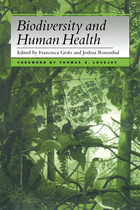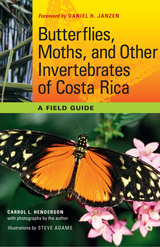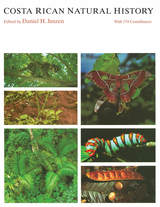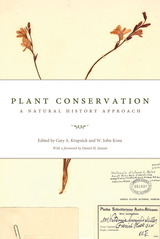
Walking a forest trail in Costa Rica, a visitor might be struck by the sight of an iridescent blue morpho butterfly fluttering ahead in the filtered daylight, or an enormous silk moth, as magnificently patterned and subtly colored as a Persian carpet, only emerging to fly at night. Elsewhere, vivid yellow and orange sulphur butterflies flock to puddles to sip the concentrated minerals. Such is the dazzling variety of the butterflies and moths unique to this region.
Gathered by biologists Daniel Janzen and Winifred Hallwachs in the forests of northwestern Costa Rica, 100 tropical butterflies and moths represent the diversity in large-format photographs by Jeffrey Miller that document the dizzying variety of shapes, colors, and markings. The photographs are accompanied by species accounts and images of the corresponding caterpillar. The authors recount these insects' feats of mimicry and migration, lift the veil on their courtship, and show how the new technology of DNA barcoding is changing the picture of Lepidopteran biodiversity.
The authors also tell the success story of Area de Conservacion Guanacaste, where the long-term work of Janzen and Hallwachs, a team of caterpillar collectors, and the participation of neighboring farming communities has deepened understanding of Costa Rica's Lepidoptera and has brought about advances in restoration ecology of tropical habitats, biodiversity prospecting, biotechnology, and ecotourism development.

Every bright monarch butterfly or striking luna moth started out in a far subtler form of nature's mosaic, a humble caterpillar. It is this early stage of life--crafted by natural selection into machines for converting a vast array of plant matter, mostly leaves, into the beautiful adults that have captivated humans for millennia--that this book brings to dazzling light. Unobtrusive as they go about their business, these caterpillars are rarely seen by humans--and are virtually never seen from the perspective presented in this sumptuous volume: photographed in extreme close-ups at a resolution that captures in sharp detail the exquisite colors and features eluding the casual observer.
Gathered by biologists Daniel Janzen, Winifred Hallwachs, and Jeffrey Miller in the tropical dry forests, cloud forests, and rain forests of northwestern Costa Rica, over 100 large-format photographs of caterpillars document the dizzying variety of shapes, vivid colors, and cryptic markings among these species. The pictures are accompanied by capsule species accounts--revealing life histories as diverse as their forms--and magnificent images of the adult butterfly or moth. Throughout, the authors convey an intimate sense of these creatures--studied over twenty-five years--by focusing on how their features figure in their behavior and ecology, and on the beauty of nature in this life stage, as well as the nature of that beauty.
The story of the caterpillars is also the success story of Area de Conservacion Guanacaste--where the long-term work of Janzen and Hallwachs, and a team of gusaneros (caterpillar collectors and rearers), along with the participation of neighboring farming communities, has deepened understanding of Costa Rica's Lepidoptera and has brought about advances in restoration ecology of tropical habitats, biodiversity prospecting, biological control of pests, biotechnology, residents' bioliteracy, and ecotourism development.

The implications of biodiversity loss for the global environment have been widely discussed, but only recently has attention been paid to its direct and serious effects on human health. Biodiversity loss affects the spread of human diseases, causes a loss of medical models, diminishes the supplies of raw materials for drug discovery and biotechnology, and threatens food production and water quality.
Biodiversity and Human Health brings together leading thinkers on the global environment and biomedicine to explore the human health consequences of the loss of biological diversity. Based on a two-day conference sponsored by the National Institutes of Health, the National Science Foundation, and the Smithsonian Institution, the book opens a dialogue among experts from the fields of public health, biology, epidemiology, botany, ecology, demography, and pharmacology on this vital but often neglected concern.
Contributors discuss the uses and significance of biodiversity to the practice of medicine today, and develop strategies for conservation of these critical resources. Topics examined include:
- the causes and consequences of biodiversity loss
- emerging infectious diseases and the loss of biodiversity
- the significance and use of both prescription and herbal biodiversity-derived remedies
- indigenous and local peoples and their health care systems
- sustainable use of biodiversity for medicine
- an agenda for the future
The book provides a common framework for physicians and biomedical researchers who wish to learn more about environmental concerns, and for members of the environmental community who desire a greater understanding of biomedical issues.

At the biological crossroads of the Americas, Costa Rica hosts an astonishing array of plants and animals—over half a million species! Ecotourists, birders, and biologists come from around the world, drawn by the likelihood of seeing more than three or four hundred species of birds and other animals during even a short stay. To help all these visitors, as well as local residents, identify and enjoy the wildlife of Costa Rica, Carrol Henderson published Field Guide to the Wildlife of Costa Rica in 2002, and it instantly became the indispensable guide.
Now Henderson has created a dedicated field guide to more than one hundred tropical butterflies, moths, and other invertebrates that travelers are most likely to see while exploring the wild lands of Costa Rica. He includes fascinating information on their natural history, ecology, identification, and behavior gleaned from his forty years of travels and wildlife viewing, as well as details on where to see these remarkable and beautiful creatures. The butterflies, moths, and other invertebrates are illustrated by over 180 stunning and colorful photographs—most of which were taken in the wild by Henderson. A detailed and invaluable appendix that identifies many of Costa Rica's best wildlife-watching destinations, lodges, and contact information for trip-planning purposes completes the volume.

"This is an extraordinary, virtually unique work. . . . The tremendous amount of original, previously unpublished, firsthand information is remarkable."—Peter H. Raven, Director, Missouri Botanical Garden
"An essential resource for anyone interested in tropical biology. . . . It can be used both as an encyclopedia—a source of facts on specific organisms—and as a source of ideas and generalizations about tropical ecology."—Alan P. Smith, Ecology

Plant Conservation opens with a broad view of plant biodiversity and then considers evolutionary and taxonomic threats and consequences of habitat alteration; specific threats to plant diversity, such as invasive species and global climate change; consequences of plant population decline at the ecological, evolutionary, and taxonomic levels; and, finally, management strategies that protect plant biodiversity from further decline. With a unique perspective on biodiversity and scientific collections, Plant Conservation ultimately emphasizes the role museums and botanical gardens will play in future conservation.

Race to Save the Tropics documents the conflict between economic development and protection of biological diversity in tropical countries.
READERS
Browse our collection.
PUBLISHERS
See BiblioVault's publisher services.
STUDENT SERVICES
Files for college accessibility offices.
UChicago Accessibility Resources
home | accessibility | search | about | contact us
BiblioVault ® 2001 - 2024
The University of Chicago Press









